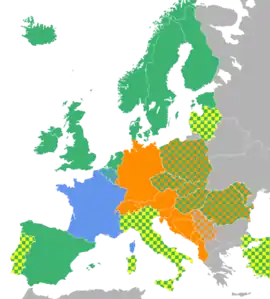QWERTZ
The QWERTZ or QWERTZU keyboard is a typewriter and keyboard layout widely used in Central Europe. The name comes from the first six letters at the top left of the keyboard: (Q W E R T Z).
Overview
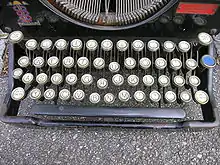
The main difference between QWERTZ and QWERTY is that the positions of the Z and Y keys are switched (hence the nickname "kezboard"). This change was made for three major reasons:
- Z is a much more common letter than Y in German; the latter rarely appears outside words whose spellings reflect either their importation from a foreign language or the Hellenization of an older German form under the influence of Ludwig I of Bavaria.
- T and Z often appear next to each other in the German orthography, and typewriter jamming would be reduced by placing the two keys so they could be typed with separate hands.
- Z and U are also next to each other. Zu, meaning "to" in German, and also a very common prefix can also be written very easily.
Similar to many other non-English keyboards:
- Part of the keyboard is adapted to include language-specific characters, e.g. umlauted vowels (ä, ö, ü) in German and Austrian keyboards.
- QWERTZ keyboards usually change the right Alt key into an Alt Gr key to access a third level of key assignments. This is necessary because the language-specific characters leave no room to have all the special symbols of ASCII, needed by programmers among others, available on the first or second (shifted) levels without unduly increasing the size of the keyboard.
- The placements of some special symbols are changed when compared to the English (UK and US) versions of QWERTY.
Some of special key inscriptions are often changed from an abbreviation to a graphical symbol (for example ⇪ Caps Lock becomes a hollow arrow pointing up, ← Backspace becomes a left-pointing arrow). In German and Austrian keyboards, most of the other abbreviated labels are in German: Ctrl (control) is translated to its German equivalent "Strg" for Steuerung, and Delete is abbreviated "Entf" (entfernen). Esc and ↵ Enter on the numeric keypad are not translated, however. (See: Key labels)
Variants
The QWERTZ layout is fairly widely used in Germany and in the majority of Central European and Balkan countries that use the Latin script. Many German-speaking regions use this layout, but the German-speaking East Cantons of Belgium uses the AZERTY instead.
Albanian
QWERTZ is the default keyboard layout for the Albanian language in Microsoft Windows.[1]
Austria and Germany
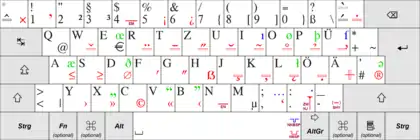
The characters shown in black are present in the traditional “T1” layout also.
The PC keyboard layout commonly used in Germany and Austria is based on one defined in a former edition (October 1988) of the German standard DIN 2137-2. The current edition DIN 2137:2012-06 standardizes it as the first (basic) one of three layouts, calling it “T1” (Tastaturbelegung 1, or “keyboard layout 1”).
It employs dead keys to type accented characters like “é”, and the AltGr key to access characters in the third level (e.g. “[”, “]”, “@”, the euro sign “€”, or the micro- “µ”). The “T2” layout as specified in the 2012 edition of the German standard also uses the group selection to access special characters like the long s, or foreign characters like “Æ” or “Ə”.
Sorbian
Sorbian QWERTZ is practically identical to the German layout, but the additional Sorbian characters can be entered with dead keys; it has three different layouts: Standard, Legacy, and Extended. All are supported by Microsoft Windows (Windows 7 and later only).[2]
Czech
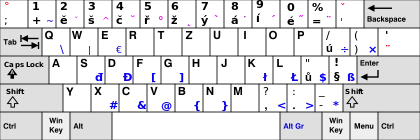
The QWERTZ keyboard layout is commonly used in the Czech Republic, but the QWERTY variant is an unofficial option. The characters from the American keyboard (@#__SUB_LEVEL_SECTION_5__amp;\|[]{}<>^`~*) and some other characters and diacritic signs (÷פ€ßĐ𣳰˘˝·˛¸) that are missing on the Czech mechanical typewriter keyboard can be accessed with the AltGr key. The layout on the picture is supported by Microsoft Windows. In internet poll in 2013 56% of Czech users used QWERTZ and 44% used QWERTY,[3] but in 2020 57% of Czech users used QWERTY and 43% used QWERTZ.[4]
Hungary

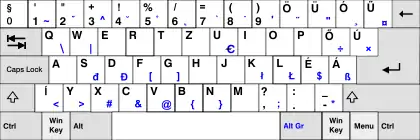
On some keyboards, the "ű" key is located to the left of the Enter key, while on others it is placed to the left of the backspace key (see the two pictures on the right).
An unusual feature of this Hungarian keyboard layout is the position of the 0 (zero): it’s located to the left of the 1, so that most of the accented characters can be together on the right side of the keyboard.
The official layout is of type QWERTZ, which is therefore the most widely used keyboard layout in the country. QWERTY used to be widespread due to there not being a dedicated Hungarian layout commonly available for older computers, but since this is no longer an issue, virtually everyone uses QWERTZ in everyday computing.
On "ISO" keyboards (as in the first picture) and "ISBAE" keyboards (as in the second), the Í key is positioned on the key to the right of the left Shift key. To adapt to 101/102-key keyboards which don’t have that key, the MS Windows QWERTY layout has put the Í on the usual key for the 0 (zero) while the 0 has been moved to that key’s tertiary (AltGr) layer; on Macintosh computers, both layouts (QWERTY and QWERTZ) have this adaptation.[5]
Poland

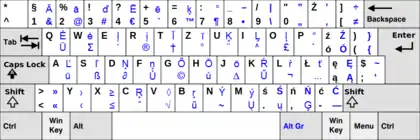
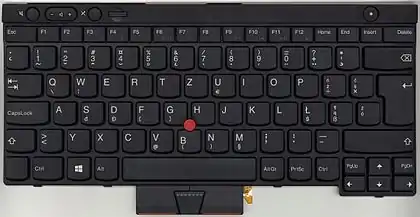
A variant of the QWERTZ keyboard has been used in Poland, but QWERTY keyboards have been dominant since the early 1990s.
Romanian

The standard keyboard layout as established by the standard SR 13392:2004 is QWERTY. However, a Romanian QWERTZ keyboard (corresponding to older standards) was set up on Windows 9x/2000/ME/XP. Since it was devised before the disunification of "Ș" (S-comma) and "Ț" (T-comma) with "Ş" (S-cedilla; used in Turkic languages) and "Ţ" (T cedilla), the characters with cedilla were used in the layout. In 2012, a revision with commas was made.[6]
Slovak
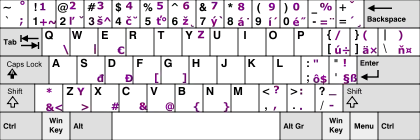
Typewriters in Slovakia have used the QWERTZ layout quite similar to the layout used on the Czech typewriters. Slovak QWERTZ layout differs from the Czech one in using the letter ľ instead of the Czech ě on the same position, also the letter ť is on the position of Czech ř and the letter ô is on the position of Czech ů. There are 2 more keys that differ in these 2 languages: Slovak ä ( key replaces the Czech ( ) key and Slovak ň ) key replaces the Czech ' ¨ key. There are 17 characters from American keyboard (@#__SUB_LEVEL_SECTION_9__amp;\|[]{}<>^`~*') that are missing on the Slovak keyboard because of the presence of the Slovak letters (ľščňťžôúáíýéä°´ˇ§). Users can access them with the AltGr key, however, position of these characters varies between different operating systems. Besides the QWERTZ keyboard layout inherited from the typewriter era, QWERTY layout is also used by computer users in Slovakia. The only difference is that the Y and Z keys are swapped.
South Slavic Latin
The Bosnian, Croatian, Serbian Latin and Slovene keyboard layout has five additional special characters Č, Ć, Ž, Š and Đ. This keyboard layout was standardized in the 1980s in Yugoslavia. Characters Ć and Đ are only part of Gaj's Latin alphabet but not part of the Slovene alphabet, nevertheless they remain in Slovenian keyboards (for economic reasons, for historical reasons and for writing words in the closely related South Slavic languages). The Ž is on the right side of the Ć key on keyboards which have a longer backspace key, and the usual inverted L shaped Enter key. The layout makes heavy use of the AltGr (right Alt) key for non-alphabetic characters and dead key combinations for adding diacritics to Latin characters. It is possible to type German and Italian using only the Bosnian/Croatian/Serbian keyboard layout.
There is a proposed variant of new Slovene keyboard layout, which would remove Ć and Đ from top layout and add @ instead. The command keys would also become translated into Slovene and some minor second level layout changes would be made.[7]
For Serbian, there is also a Cyrillic keyboard variant, in which Q and W are replaced with Љ (Lj) and Њ (Nj) respectively.
Switzerland (German, French, Italian, Romansh), Liechtenstein, Luxembourg

The layout of the Swiss keyboard is established by the national standard SN 074021:1999. It is designed to allow easy access to frequently used accents of the French, German and Italian languages and major currency signs. It was designed from the beginning for usage with multiple languages, also beyond Swiss languages, in mind.[9] The difference between the Swiss German (SG) and the Swiss French (SF) layout is that the German variety has the German umlauts (ä, ö, ü) accessible in the unshifted state, while the French version has some French accented characters (é, à, è) accessible in the unshifted state. The actual keyboards have the keys engraved for both variations; the difference is only in the driver (software) settings. In the latest versions of Windows there are also separately listed driver settings for Swiss Italian and Swiss Romansh, but they correspond to the Swiss French and Swiss German layout, respectively. In Mac OS X 10.6, only Swiss French and Swiss German is available, and on iPadOS, the Swiss German layout is not supported for any language other than German.
On Windows, Swiss German does not include the esszett (ß) ligature, which is only used in Germany and Austria, meaning that that letter is unimportant in Switzerland, and is therefore not found on the keyboard. Linux typically assigns ß to AltGr-s.
While the German keyboard uses German labels for its keys (e.g. Strg instead of Ctrl), Swiss keyboards use the English abbreviations as a "neutral" solution, as they are used for all the national languages of Switzerland.
Luxembourg does not have a keyboard layout of its own. Public education and administration use the Swiss-French keyboard which also represents the Microsoft Windows standard keyboard layout for Luxembourg, while some of the private sector prefer the Belgian layout . Other places may use the US layout. Liechtenstein, which mostly speaks Swiss German and the Liechtenstein German dialect, also use the Swiss German layout without an ß character.
See also
| Wikimedia Commons has media related to QWERTZ keyboard layouts. |
- AZERTY
- QWERTY
- QZERTY
- German keyboard layout
- Blickensderfer typewriter
- Dvorak keyboard layout
- Neo, an optimized German keyboard layout
References
- "Microsoft's implementation of the Albanian layout". microsoft.com. Microsoft.
- "Microsoft Keyboard Layouts". Microsoft. Archived from the original on 13 July 2017. Retrieved 26 May 2017.
- https://www.zive.cz/clanky/bitva-o-klavesnici-qwerty-qwertz-i-naprosta-exotika/sc-3-a-170708/default.aspx
- https://www.cnews.cz/klavesnice-qwerty-samsung-smartphony/
- Microsoft keyboard layouts
- Cristian Adam. "The Română (Moștenit) keyboard" (in Romanian). Retrieved 27 November 2012.
- "SLOVENSKI STANDARD oSIST 1044" (PDF). February 2009. Archived from the original (PDF) on October 24, 2014. Retrieved September 14, 2013.
- How to identify keyboard localizations - Apple Support
- "Informationstechnologie - Anordnung der alphanumerischen Tastenfelder für Geräte der Daten- und Textverarbeitung" (in German). SN 074021:1999-01. Schweizerische Normen-Vereinigung (SNV). 1 Jan 1999. Cite journal requires
|journal=(help)
